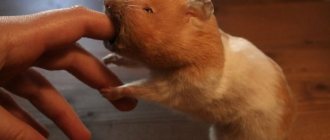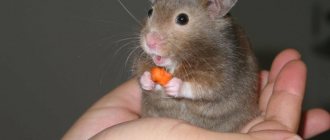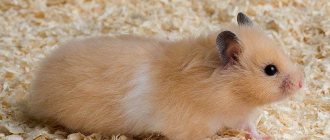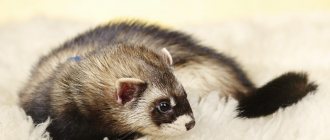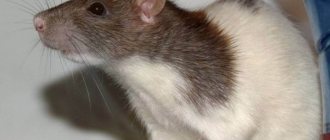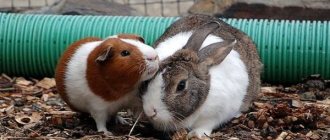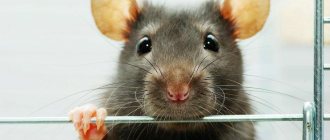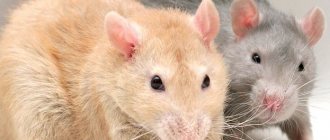What types of hamsters are there? How to distinguish them from each other? What types of hamsters are suitable for keeping at home? You will find answers to these questions in the article.
Let’s make a reservation right away that we will only talk about varieties of hamsters that can be tamed and domesticated. Let's take a quick look at wild rodents.
If you don’t understand breeds, this will grow up.
Dzungarian (aka Sungur)
Baby jungarik.
Yes, this is not a typo - the Dzungarian hamster and the Sungur hamster are the same breed. In common people, the pet is called a dzhungarik after the name of the region in China, its natural habitat. Sungurik - from the scientific name Phodopus sungorus.
Other erroneous names for dwarf hamsters are Siberian hamster and Russian dwarf. Such breeds of pets do not exist in the classification; if they are trying to sell you a Siberian or Russian at an inflated price, find another seller.
Sungursky is a dwarf species, grows up to 10 cm in length and gains a weight of 45-65 grams. The “feet” on the paws are covered with hair. The color on the back is dark, on the belly it is almost white. A characteristic difference is a clearly defined thin dark stripe along the ridge.
The “standard” back color is brown or dark gray. But there are decorative colors:
- Sapphire (gray with a bluish tint);
- Pearl (snow-white);
- Tangerine (similar in color to the golden Syrian).
The Dzhungarik changes its coat color depending on the time of year (lighter in winter), but this rarely happens at home.
The character is perhaps the friendliest among all hamsters. Djungarians often like to be stroked on their backs and bellies; they willingly fall asleep in your arms.
Lives in captivity for an average of 3 years, but with proper care, 4 are possible.
You can house opposite-sex pairs (just keep in mind that they will reproduce quickly and actively). It is better not to keep same-sex Dzungarians together; they do not get along well.
The tiny size leaves an imprint on the maintenance and feeding of the baby. Read about care in detail in this material.
Home equipment
The features of keeping an albino hamster are similar to the conditions for ordinary species of these rodents. Hamsters tolerate a solitary lifestyle very well, so they do not require companions. In addition, in nature they fight for their territory, and therefore have an extremely negative attitude towards their neighbors. This character trait should be taken into account when purchasing a rodent.
For the animal you need to purchase a spacious cage. The larger its size, the more comfortable he will feel. The minimum size is 30 x 50 cm. The rods must be metal, since hamsters quickly chew off plastic structures. The larger the animal, the larger the house it will need. It’s great if it has a large number of labyrinths and holes that the rodent really likes.
Syrian
The golden king of children's hearts.
The second most popular species is the Syrian hamster. This species is medium-sized and much larger: the body length is considered to be 12 cm, but there are individuals up to 20 cm tall (this is the largest hamster among pets). The usual color is golden (reddish, peach). Often, for marketing purposes, sellers call this breed Royal, and the name Yellow Hamster is found. Many consider it the most beautiful breed.
There are simply countless decorative colors obtained as a result of selection. The Syrian can be of almost any color, as well as multi-colored.
The character is a little more absurd than that of the Djungarians, but you can tame the Syrian. Females are angrier than males, so we recommend boys for solitary housing. If you are planning to get several Syrian animals, house them separately, even in pairs (only house them for the duration of mating).
They live 3-4 years; long-livers have been known to live up to 5 years.
We have outlined everything you need to know about the maintenance and nutrition of the Syrian breed in this article.
Angora hamster
There is no breed of Angora hamster. This is often the name given to Syrians who are extremely shaggy and have long hair (up to 10 cm). Decorative breed, famous for its fluffiness. The coat requires additional care - keep this in mind if you are planning to get a shaggy hamster.
Golden hamster
Naturally colored Syrians are most often called golden, but there are also representatives of other breeds of this color (for example, tangerine dzhungarik).
Interesting facts about the rodent:
- The word “hamster” is of Old Church Slavonic origin, in turn borrowed from ancient Iranian, where “hamaēstar” is translated as “an enemy who throws to the ground.” This probably indicated that the hamster bends the stem of the cereal towards the ground and thus gets the seeds.
- The Syrian and Newton's hamsters are included in the International Red Book.
- Hamsters cause damage to agriculture as they feed on legumes and grain crops. In addition, they are carriers of pathogens of a number of infectious diseases, which is why their keeping is prohibited in Vietnam. The maximum fine for violation is 30 million VND, which is equal to the annual income of a resident of this country. But hamsters also bring benefits. For example, the skins of certain types of hamsters are harvested. Hamsters are also used as laboratory animals and pets.
Campbell's hamster
The closest relative of the dzhungarika is Campbell.
Another representative of the dwarf breed. It is very similar to the Djungarian, both in size and color, so it is not easy to recognize the breed. The main differences between Campbell and Dzungarian:
- The color has a golden tint, while the Djungarian has a darker coat.
- When viewed from above, the shape resembles a figure eight, while the jungarik has an oval
- The stripe on the back is less distinct
The signs are not exact, so we advise you to read the material on our website, which covers in detail the question of how to determine the breed of hamster (to distinguish a hamster from a Campbell).
Life is shorter than that of the Dzungarian breed, on average 2 years in captivity.
Roborovsky's hamster
Less than small - Roborovsky's baby.
The smallest hamster we recommend for home keeping is the Roborovsky hamster. It grows only 4-5 cm in length. The back is golden or dark brown, the belly is white. Hamsters live in captivity for up to 4 years.
They are very difficult to tame, but this is the only breed that can be housed in groups of the same sex. Those. this species is no longer for those who like to “squeeze” hamsters, but for those who prefer to watch the life of a colony of nimble babies.
Answers to popular questions
Before getting their first hamster, people ask many questions. We have collected the most popular of them and will try to provide brief information.
What breed of hamster is best to buy for a child?
Several factors need to be taken into account: the age of the child, how many hamsters you plan to buy, whether you can look after him and devote a lot of time.
Let's say the only hamsters that can respond to a name are Syrian ones. Djungarians live only one at a time. Campbell's are more social, they need a friend so they don't get bored.
Hamster and baby
Males of any hamsters, as a rule, are larger than females, but more “fragrant” because they mark their territory, i.e. You need to clean the cage more often. Are you and your child ready for this? You should not completely entrust the maintenance of the animal to the child; be sure to control the processes.
What is the largest breed of hamster?
The largest hamster is the Karbysh breed. Its dimensions reach 35 cm and weight up to 700 g. It lives only in the wild and cannot be tamed. Among domestic hamsters, the largest is the Syrian.
What is the smallest breed of hamster?
The smallest breed of hamster is the Roborovsky. And among the wild ones is Taylor's hamster.
Djungarian or Syrian hamster, which is better to get?
This question is quite broad. Take whoever you like best.
What are the differences between these breeds? The Syrian hamster is larger, calmer, and will be able to respond to its name. Such a hamster needs a cage more than a dwarf.
Djungarian hamster eats seeds
The Djungarian hamster is smaller, more mobile and does not need a two-story cage.
The life expectancy of both is almost the same.
Common hamster
The most common wild pest.
It is difficult for sellers to understand what kind of animal the buyer considers “ordinary”, so they can sell anything. Let's clarify this issue: the common hamster (aka wild, aka karbysh) is a significant pest of human crops and is almost never found as a pet.
What does a normal hamster look like? It reaches a length of 35 cm, has a long tail - up to 8 cm. The abdomen is usually black, the back and sides are bright and spotted. Not recommended for keeping or taming.
Albino hamster with red or black eyes
Such a handsome man can be of any breed.
And again we have to disappoint you - there is no separate breed of albinos with a specific eye color. Almost any living creature (even humans) can be born an albino.
Usually hamsters have black eyes, but albinos often have impaired eye pigmentation (this is the color on the inner surface of the eyeball). As a result, it becomes transparent and the red color we see is blood vessels.
An albino with any eye color is no different in caring for an ordinary animal of the same breed.
How to care for wool?
The white hamster looks beautiful, but its fur needs care, and more carefully than that of individuals of other colors. You can't bathe rodents! For hygienic purposes, you need to purchase special sand at the pet store. Hamsters enjoy using it to clean their fur.
Sand for rodents should not contain talc. It is poured into a birdbath 2-3 cm thick. It is good if the container is transparent and you can watch the rodent bathing. If at first the animal does not show interest in the new entertainment, just wait - after a while the hamster will definitely start bathing.
Sand baths are organized 1-2 times a week, lasting no more than half an hour. It is important to ensure that the sand remains clean. After bathing it is sifted.
To preserve the whiteness of the fur, experts do not recommend keeping albinos together with individuals of normal color.
Other breeds of hamsters
Let's take a look at the representatives of hamsters that are not recommended to be kept at home. You need to know about them, at least so that they don’t slip you a wild animal under the guise of a domestic, soft and fluffy pet.
Hamster Radde
A large and well-fed pest is Radde.
The very prolific Radde hamster is a wild pest that can gain 1 kg of weight with a length of up to 28-30 cm. Appearance: the main brown color is combined with light inserts on the abdomen and face.
Eversmann's hamster
Eversmann's rodent.
Eversmann's hamster, which lives mainly in Mongolia, has an average height of 15 cm and a short tail (up to 2 cm). The predominant color is a brown back with a light belly with a dark spot on the chest. There is a variety of Eversmann's hamster - Mongolian. Differences from the first:
- Mongolian is a little less
- The color is lighter (closer to gray)
- No spot on chest
Chinese hamster
Chinese "cross between" Dzungarian and mouse.
The Chinese hamster lives, as the name implies, in the former Celestial Empire. A small (10 cm) brown animal with a dark stripe along the ridge. Very similar to a mouse, the bare tail adds to the similarity.
Hamster Sokolov
A little-studied species of Sokolov.
Even scientists know little about Sokolov’s hamster. It lives in Mongolia and China, reaches a length of slightly more than 10 cm. The skin on the back is gray with a dark stripe, the belly is light.
Barabinsky hamster
Barabinsky.
The Barabinsky hamster is native to Western Siberia and Mongolia. Grows up to 13 cm. Color – light brown, sometimes reddish, with a stripe on the back. The belly is lighter, sometimes even white. An interesting feature is the two-color ears (with a white border at the edges).
The Daurian hamster is a variety of the Barabinsky breed. It is distinguished by a darker color and a clearly defined spinal stripe.
Newton's hamster
The name is “smart”, but the character is evil.
Similar to the Syrian, both in shape and size (grows up to 17 cm). The fur on the back is gray-brown, the muzzle and chest are reddish. Unlike the Syrian breed, the character is vicious.
Short-tailed hamster
Surviving at an altitude of 4-5 thousand meters is not easy.
The short-tailed rodent is a high-mountainous inhabitant, the main habitat is Tibet.
Grows up to 8-10 cm. Color is a mixture of gray, yellow and brown.
Care and maintenance
Hamsters are animals that are easy to keep at home. They do not take up much space, do not spoil furniture, do not scatter wool around the apartment, and do not need to be walked. In addition, they eat little and need almost nothing.
Cage and filler
The hamster is kept in a cage made of metal bars. The minimum size of the structure is 30x25 cm. The height can be any. If desired, you can arrange a second level for the rodent. It is connected to the first floor by a ladder or tunnel.
When choosing a cage for a dwarf hamster, you should pay attention to the distance between the bars. It should not exceed 0.8 mm. Otherwise, the pet may squeeze through the bars and escape.
It is good if the cage is equipped with a pull-out tray and plastic sides at the bottom. Thanks to them, the filler will not spill out of the hamster’s home. The door must close tightly.
Inside the rodent cage the following is installed:
- house - a place where the rodent sleeps;
- running wheel - needed to maintain good physical shape and have fun;
- feeder;
- drinking bowl;
- a sand bath for bathing.
A layer of filler 2 cm thick is poured onto the bottom. It is better to use wood shavings, pressed sawdust, or chopped corn cobs as bedding.
Hygiene
Cleaning the rodent cage is done every 5-7 days. Failure to comply with this requirement will result in an unpleasant odor. Dirty litter and leftover food are thrown away, the tray, feeder and drinking bowl are washed with hot water. Stubborn stains are removed with soda solution.
The rodent's house is also cleared of garbage and food supplies.
It is not recommended to bathe hamsters. They take care of their fur on their own. If the fur smells, it is only due to the fault of the owner, who rarely cleans the cage. In nature, hamsters bathe in sand. This is why a sand bath is necessary.
If the rodent is heavily soiled with a substance that is dangerous to lick, you can carefully trim off the dirty fur or clean it with a cotton pad soaked in water.
Taming
There is nothing difficult in taming a rodent, but regularity is important. It is necessary to pay attention to it every day and pick it up.
Syrian and Djungarian hamsters are the easiest to tame. In the first days after arriving at a new family, the rodent experiences stress, so it is better not to touch it. When he gets used to it a little, you can start taming him.
At first, the owner should simply approach the cage and offer the pet some kind of treat through the bars. When the hamster begins to take treats without fear and with confidence, you can move on to the next step.
Next, do the same with the door open. The treat is placed in the palm of your hand and you wait for the rodent to come up and take it. A little time will pass and the hamster will sit on your hand and eat from it. The main thing is not to make sudden movements so as not to scare him.
